Results 9,131 to 9,140 of 12096
Thread: Anandtech News
-
02-01-19, 09:49 AM #9131
Anandtech: Philips Brilliance 499P9H Ultra-Wide 49-Inch Monitor Now Available
First introduced back at IFA 2018, Philips has started to sell their latest 49-inch ultra-wide display, the Philips Brilliance 499P9H. Utilizing a 32:9 aspect ratio panel with a 5120 x 1440 resolution and a curve to match, Philips' latest monitor is aimed primarily at business users, looking to overwhelm with both its sheer size and the inclusion of buisness-friendly features such as a pop-up webcam, USB Type-C docking, a KVM switch, and a GbE controller.
More...
-
02-01-19, 12:31 PM #9132
Anandtech: GlobalFoundries to Sell 200-mm Fab 3E to Vanguard, Exits MEMS Business
GlobalFoundries announced on Thursday that it had agreed to sell its Fab 3E in Singapore to Vanguard International Semiconductor (VIS) as part of a broader plan to exit the MEMS business by the end of the year. The deal will be a wholesale handoff to Vanguard, and both the customers that use the fab and the personnel that work there will be transferred to the new owner. For their part, selling the fab and exiting the MEMS business will allow GlobalFoundries to raise the capital it needs upgrade its other fabs, as well as further invest in technologies that are used to make chips using the company’s other specialized manufacturing processes.
Under the terms of the agreement, GlobalFoundries will sell its Fab 3E located in Tampines, Singapore, to Vanguard for $236 million with transfer of the ownership set to be completed on December 31, 2019. The fab is used to make microelectromechanical systems (MEMS) as well as analog/mixed signal chips, with a production capacity of around 35,000 200-mm wafer starts per month. In addition to the building and equipment, Vanguard will also get GlobalFoundries’ MEMS-related IP. Vanguard in turn will offer employment to the staff of Fab 3E, essentially continuing with the current team. Furthermore, VIS will inherit customers currently served by the production facility.
Vanguard’s existing manufacturing have been running at full capacity since 2018, so by getting GlobalFoundries’ Fab 3E VIS will not only get new customers, but it will also expand its production capabilities. Because MEMS is a growing market, the deal is a clear win for the company.
Meanwhile GlobalFoundries will get $236 million for the sale, which it will invest in other 200-mm fabs and technologies where the company is more clearly differentiated from its competitors. This includes RF, embedded memory, advanced analog, and so on. Since specialized manufacturing processes are a lucrative business, shifting from MEMS is a logical move for the company. Plus it will also help GlobalFoundries to lower its operating costs.
“This transaction is part of our strategy to streamline our global manufacturing footprint and increase our focus in Singapore on technologies where we have clear differentiation such as RF, embedded memory and advanced analog features,” said GF CEO Tom Caulfield. “Consolidating our 200mm operations in Singapore into one campus will also help reduce our operating costs by leveraging the scale of our gigafab facility in Woodlands. VIS is the right partner to leverage the Fab 3E asset going forward.”
Related Reading:
- GlobalFoundries Stops All 7nm Development: Opts To Focus on Specialized Processes
- GlobalFoundries and Chinese Authorities Reconsider Plans
- GlobalFoundries Announces 22FDX Milestone: $2 Billion in Design Wins
- GlobalFoundries to Expand Capacities, Build a Fab in China
Source: GlobalFoundries
More...
-
02-01-19, 03:40 PM #9133
Anandtech: Samsung Teases Foldable Galaxy Smartphone: Galaxy F?
Samsung Vietnam has accidentally published (and subsequently removed) a brand advertisement video that shows a glimpse at the company’s existing, conceptual, and presumably upcoming products. Among other things, the footage depicts the company’s rumored foldable Galaxy smartphone (often quoted as 'Galaxy F', or 'Galaxy X') as well as bezel-less Galaxy tablet. Obviously, there is no word about release dates, but the video shows the direction that Samsung wants to take.
More...
-
02-02-19, 10:51 AM #9134
Anandtech: Intel 28-Core Xeon W-3175X Spotted at Retail in Japan: $3880
One of the comments we got from Intel about the new unlocked 28-core Xeon W-3175X processor was that it would only be available through boutique system integrators or OEMs, like Dell or HP. It now transpires that Intel is intending to sell these processors with full retail packaging. As spotted on Twitter, the parts have already been showing up in the Tokyo Tech Plaza in Japan, for an eye-watering $3880 (plus 8% JPY sales tax).
More...
-
02-04-19, 09:24 AM #9135
Anandtech: OWC Unveils Second-Gen ThunderBlade External SSDs: 2800 MB/s Starting at $
OWC this week introduced its second-generation ThunderBlade external SSDs, which are aimed squarely at the high-end, max performance external storage market. Offering up to 2800 MB/s sequential read speeds, the new drives offer the same performance as the first-generation ThunderBlade SSDs, but are priced significantly lower.
OWC’s ThunderBlade (Gen 2) DAS devices are available in 1 TB, 2 TB, 4 TB and 8 TB configurations, just like their predecessors. While the first-generation ThunderBlade drives were based on four Mercury M.2 SSDs (Silicon Motion SM2260, LDPC, 3D MLC NAND) working in concert, the ThunderBlade (Gen 2) devices use cheaper SSDs, almost certainly featuring modern 3D TLC NAND. Since 3D TLC is cheaper than 3D MLC, the ThunderBlade Gen 2 drives start at $799, down from $1,199 in case of the first-gen.
Performance-wise, the new and "old" ThunderBlades offer the same official specs: both generations are rated for up to 2800 MB/s sequential read speed as well as up to 2450 MB/s sequential write speed (keeping in mind performance levels offered by four PCIe 3.0 x4 SSDs, these must be sustained speeds). Meanwhile, when two ThunderBlade (Gen 2) drives are used and SoftRAID technology is enabled, performance levels go all the way up to 3800 MB/s, which is the maximum performance level offered by one PCIe 3.0 x4-based ThunderBolt 3 controller. Speaking of TB3, it should be noted that the latest ThunderBlade is still based on Intel's DSL6540 "Alpine Ridge" controller, so there's no USB fallback here.
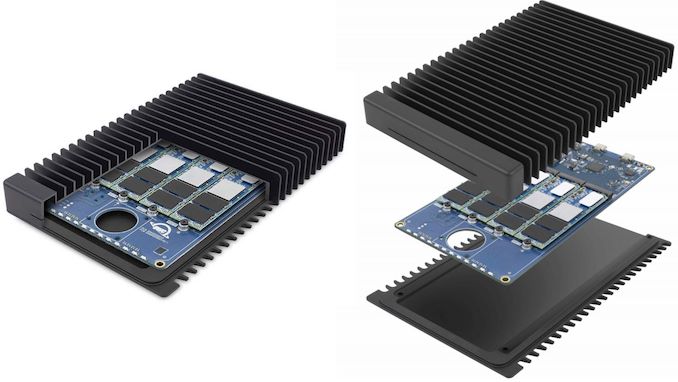
OWC’s ThunderBlade devices feature two Thunderbolt 3 ports and support daisy chaining to enable portable high-performance storage systems with up to 48 TB capacity.
Given the fact that the ThunderBlade (Gen 2) is meant to be a quick and efficient replacement for the first-gen ThunderBlade, the latest version of the DAS comes in the same rugged metal enclosure, which also acts like a cooling system for the NVMe SSDs.The OWC ThunderBlade DAS 1 TB 2 TB 4 TB 8 TB Number of Drives 4 Internal RAID ? Sustained Read Speed 2800 MB/s
3800 MB/s with SoftRAID (two DAS are needed)Sustained Write Speed 2450 MB/s Ports 2 × Thunderbolt 3 PSU external Dimensions Width 12.3 cm | 4.9 inch Length 19.2 cm | 7.5 inch Height 3 cm | 1.2 inch Weight 0.7 kg | 1.8 lb Cables Included Thunderbolt 40Gb/s cable
power adapter + cordCompatibility macOS 10.13 or later
Windows 10 or laterPrice (MSRP) Gen 1 $1,199.99 $1,749.99 $2,799.99 $4,999.99 Gen 2 $799 $1,199 $1,899 $3,499
OWC has already started sales of its ThunderBlade (Gen 2) external SSDs. As noted above, the 1 TB flavor is priced at $799, whereas the top-of-the-range 8 TB model costs $3,499.
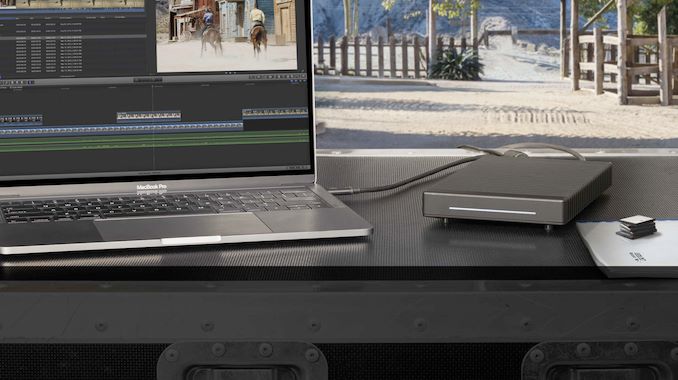
Related Reading:
- OWC Ships ThunderBlade External SSDs, Touts SoftRAID Tech for 3800 MB/s Speeds
- OWC Launches Drive Dock with USB Type-C: Two SATA Drives, Up to 981 MB/s
- OWC and SoftRAID create ThunderBay 4 RAID 5 Edition
- OWC Acquires AKiTiO, Creates Peripheral Powerhouse
Source: OWC
More...
-
02-04-19, 10:34 AM #9136
Anandtech: LG Launches Midrange 32UL750-W Monitor: DisplayHDR 600 with FreeSync & USB
In the recent years LG has introduced a number of high-end Ultra-HD 31.5-inch displays, many of which have received a lot of publicity due of their features and innovative technologies. As of late, the company has also expanded into midrange and entry-level segments with its 31.5-inch monitors. And to that end, this week LG has begun selling its 32UL750-W Ultra-HD LCD, a midrange 4K display for customers who want something better than the company's mainstream offerings, but are not ready to invest in a high-end model.
The LG 32UL750-W is based on a 31.5-inch VA panel that offers a 3840×2160 resolution, 400 nits typical brightness, a 3000:1 contrast ratio, 178° viewing angles, a 60 Hz refresh rate (with FreeSync), and a 4 ms response time. The DisplayHDR 600 badge that the monitor carries obviously points to 600 nits peak brightness along with HDR10 processing capabilities, but LG is not publishing any information about local dimming and LUTs (look-up-tables) for HDR. Meanwhile the panel can reproduce 1.07 billion colors and covers 95% of the DCI-P3 color space (and should be able to hit 100% of the sRGB color gamut).
To make the monitor more attractive for the target audience, the 32UL750-W display comes factory calibrated and supports a number of features designed for gamers, including LG’s Black Stabilizer (makes dark scenes brighter) and Dynamic Action Sync (minimizes input lag), as well as AMD's FreeSync already mentioned before.
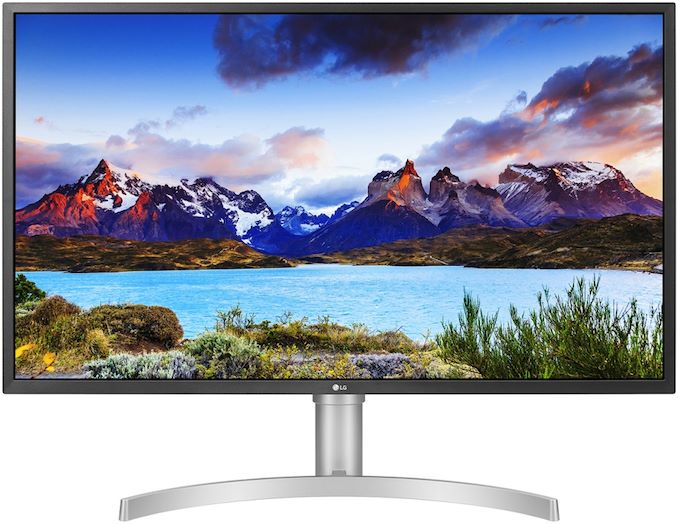
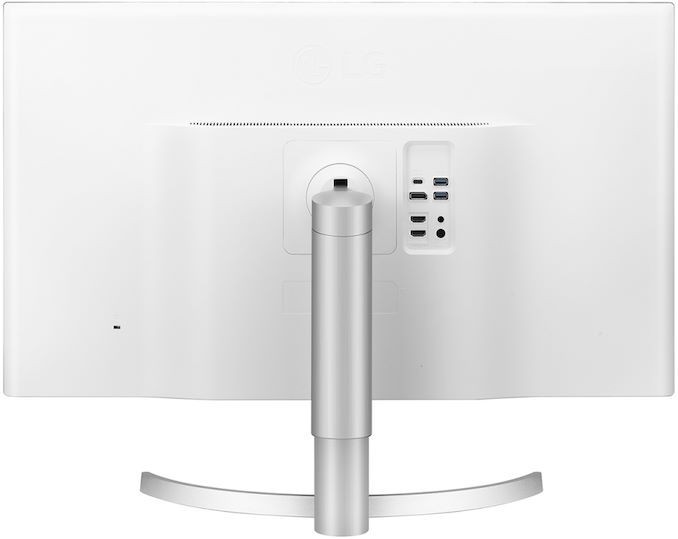
Connectivity is another strong selling point of the 32UL750-W. The monitor has a DisplayPort 1.2 input, two HDMI 2.0b ports, as well as one USB Type-C connector. The latter supports up to 60 W power delivery, so it can help to power many modern laptops. As for audio, the display has two 5 W speakers and a headphone output. As an added bonus, it also features a dual-port USB 3.0 hub.
Looking at LG's broader lineup, the LG 32UL750-W sits right between the company’s range-topping 32UK950/32UL950 Ultra-HD monitors, which use panels with LG’s Nano IPS technology, as well as its more reasonably-priced 32UK550 Ultra-HD display. The high-end 31.5-inch LCDs from LG retail for $1000 ~ $1300, whereas the cheaper 31.5-inch monitor costs around $500. The new 32UL750 will, in turn, cost approximately $749 (SRP) in the US, placing it between the other models in both features and pricing.Specifications of the LG 32UL750-W Display 32UL750-W Panel 31.5" VA Native Resolution 3840 × 2160 Maximum Refresh Rate 60 Hz Response Time 4 ms Brightness 400 cd/m² (typical)
600 cd/m² (peak)Contrast 3000:1 Viewing Angles 178°/178° horizontal/vertical HDR HDR10 Dynamic Refresh Rate AMD FreeSync/VESA Adaptive-Sync
(at 40 ~ 60 Hz)Pixel Pitch 0.1816 mm² Pixel Density 140 ppi Display Colors 1.07 billion Color Gamut Support DCI-P3: 95%
sRGB: 100%Stand Tilt and height adjustable Inputs 1 × DisplayPort 1.2
2 × HDMI 2.0a
1 × USB-C with 60 W PD
HDCP 2.2USB Hub Dual-port USB 3.0 hub Audio 5 W × 2
audio out portLaunch Price $700 ~ $750
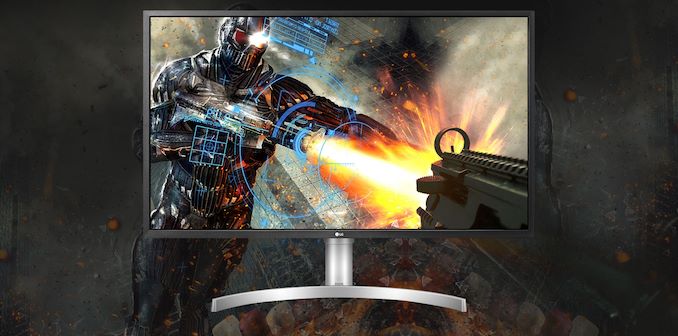
LG started to sell its 32UL750-W LCD in Japan this week at a price of ¥76,800 ($705) without tax. That said, expect the display to show up in other countries shortly. Which, keeping in mind that electronics prices in Japan tend to run a bit high by global standards, I wouldn't be surprised to see street prices for the monitor in the US come in below its official $749 MSRP.
Related Reading:
- LG Develops ‘Nano IPS’ LCD, Unveils 32UK950 4K Display with DCI-P3, HDR600, TB3
- LG Unveils 32UK550: 31.5 Inch 4K Display with DCI-P3, HDR10, & FreeSync for $500
- LG Launches 32QK500-W QHD Display: IPS and Freesync for $300
Source: LG (via PC Watch)
More...
-
02-04-19, 08:07 PM #9137
Anandtech: EGlobal's NUC-Like PC Packs Intel’s Unlocked Hex-Core i7-8750HK CPU
EGlobal, a PC maker from China, has started sales of its ultra-compact form-factor (UCFF) S200 PC. Uncommon for UCFF PCs, EGlobal's latest machines are based around Intel’s 45W laptop parts rather than their 65W+ desktop parts, somewhat limiting the vendor's chip options, but giving them more flexibility in terms of design. Case in point, the EGlobal S200s are only slightly larger than Intel’s own NUCs, but with the high-end Core i7-8750HK or Intel Xeon E-2176M inside they can offer considerably higher levels of performance.
When Intel introduced its first NUC UCFF computers in 2013, it not only entered the market of PCs with own-brand products, but it demonstrated its partners among makers of desktops that UCFF PCs were not only feasible from technology point of view, but also popular among end users. Since then, Intel has been releasing new versions of its NUCs, whereas its partners have been trying to refine their own UCFF PC products in an attempt to offer something unique. EGlobal is among companies that have managed to develop something unique: the S200 system measures 5.6 × 5.3 × 2.5 inches, yet it packs a rather powerful processor.
The EGlobal S200 is based on Intel’s Coffee Lake-H mobile CPUs, with the manufacturer offering the Core i5-8300H, Core i7-8750HK, or Xeon E-2176M as options. The system also has two SO-DIMM slots for DDR4 memory (thus supporting up to 32 GB), an M.2 PCIe 3.0 x4 slot for an SSD, as well as a 2.5-inch bay for a SATA storage device. The CPU is cooled using a rather simplistic air cooling system featuring an aluminum radiator, which should be plenty for stock performance, but it remains to be seen whether it would be enough for overclocking of the unlocked Core i7-8750HK.
When it comes to connectivity, the S200 has an 802.11ac + Bluetooth Wi-Fi controller, a GbE port, four USB 3.0 Type-A ports, a USB Type-C port, and two display outputs (a mini DisplayPort and an HDMI port). Notably, there isn't any Thunderbolt support here, so expandability options are limited to USB, and this would rule out using an eGFX chassis with the PC.
Various versions of EGlobal’s S200 are available at AliExpress, with prices ranging from $327 to $1058 depending on configuration.
Related Reading:
- ASRock Jupiter: 1 Liter UCFF PCs with Six-Core Coffee-Lake CPUs
- ASUS Announces VivoMini VC65-C1 SFF PC with Ultra HD Blu-Ray & Core i7-8700T
- CES 2019: ECS SF110-A320 Ultra-Compact PC using AMD Ryzen
- 10nm Cannon Lake NUC at Major US Retailers
- Shuttle XPC Slim DH370 Barebones PC: Coffee Lake with Three 4K Display Outputs
Source: Liliputing
More...
-
02-05-19, 09:39 AM #9138
Anandtech: The Apple iPhone XR Review: A Different Display Leads To Brilliant Battery
The latest generation of iPhones have been out for a couple of months now – we’ve extensively reviewed the iPhone XS and iPhone XS Max shortly after their official release. Missing in the review was the lower-tiered iPhone XR – the main reason for this being Apple deciding to release this variant a month after the original XS models had become available. Today, albeit a bit late, we finally got the chance to get our hands on a unit, and investigate some of the differentiating factors of the iPhone XR – such as the LCD screen and the phone’s overall battery life.
More...
-
02-05-19, 09:39 AM #9139
Anandtech: Cisco Documents Shed Light on Cascade Lake, Cooper Lake, and Ice Lake for
In a publicly available document, found by an eagle-eyed user on Twitter, Cisco has revealed some details about the future Whitley Platform and Barlow Pass: the set of technologies on which Cooper Lake and Ice Lake Xeon Scalable will be based.
More...
-
02-05-19, 05:36 PM #9140
Anandtech: Intel Details Plans for Its Oregon Fab Expansion: D1X Phase 3
Intel this week revealed the first details concerning its fab expansion plans in Oregon. As it turns out, the company intends to build the third phase of its D1X fab, and that the latest expansion (mod) will be similar in size to each of the first two phases of D1X. Intel plans to start construction later in 2019, so the new fab will be ready in the coming years.
As a part of its preparations to begin construction, Intel had to notify local residents about its intentions. On Monday the company contacted 50 residents living near its Ronler Acres campus about its intention to build a third phase of its D1X manufacturing facility. Just like the previous two buildings, the new fab will be approximately 1.1 million square feet (~102 thousand square meters) in size, according to a media report, but Intel yet has to disclose its official numbers. In addition to the factory, the company will have to build a new technology building with emergency generators, and utilities.
The processor giant has to disclose many more details about its D1X Phase 3 fab, including actual production capacity as well as process technology that it will use. Two of Intel’s fabs — in Israel and Oregon — are ready to produce CPUs and other products using the company’s 10 nm fabrication process, but it remains to be seen how much additional 10 nm capacity the company will need.
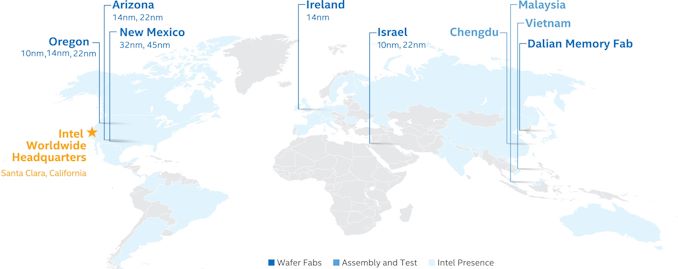
Intel announced plans to expand its production facilities in Oregon, Ireland, and Israel, in late 2018. A year before, it said it would furnish its Fab 42 in Arizona in a bid to build chips using its 7 nm process technology that relies on DUV and EUV lithography tools. Back in January 2019 it was also revealed that Intel also intends to build another massive fab in Israel.
Related Reading:
- Intel to Expand Production Capacities at Multiple Fabs
- Intel Considers $11 Billion Fab in Israel
- Israeli Parliament Approves Intel Fab 28 Expansion Grant
- Intel: EUV-Enabled 7nm Process Tech is on Track
- ASML to Ship 30 EUV Scanners in 2019: Faster EUV Tools Coming
Sources: OregonLive.com, Intel
More...
Thread Information
Users Browsing this Thread
There are currently 30 users browsing this thread. (0 members and 30 guests)




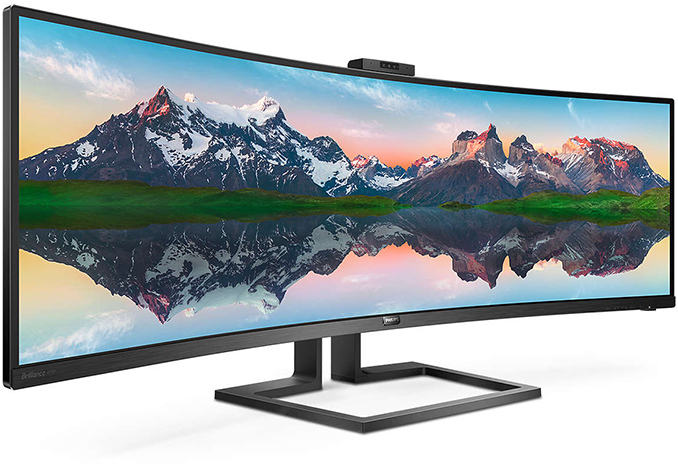

 Quote
Quote
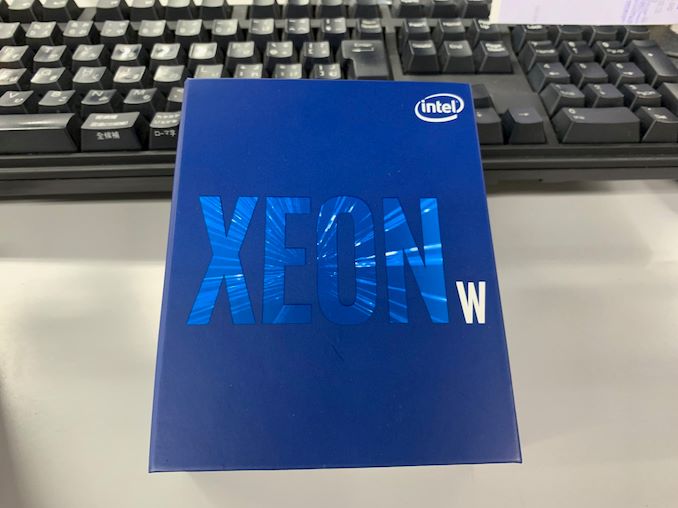

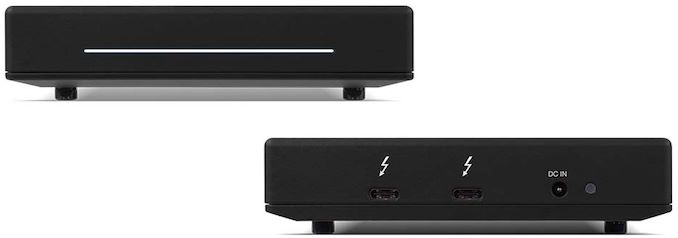


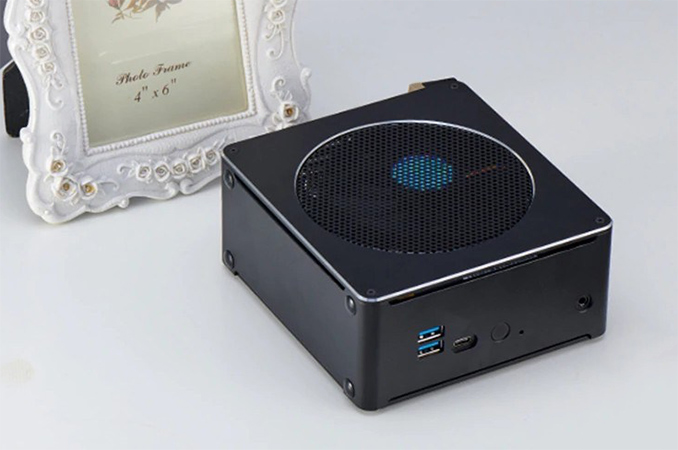
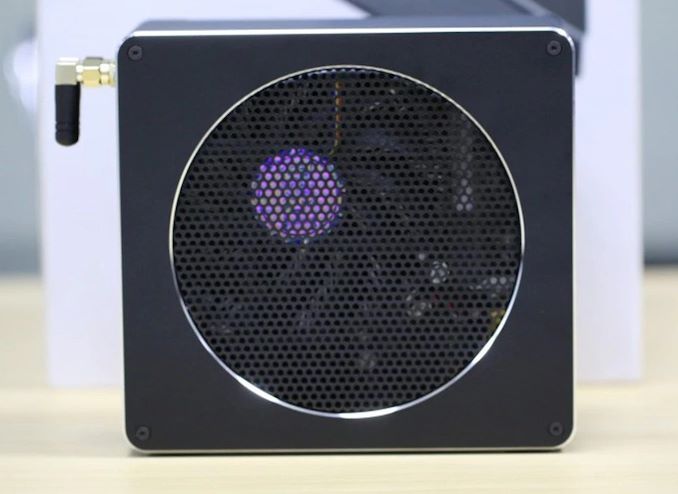
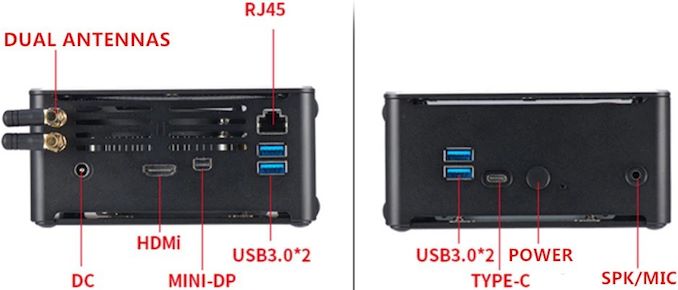

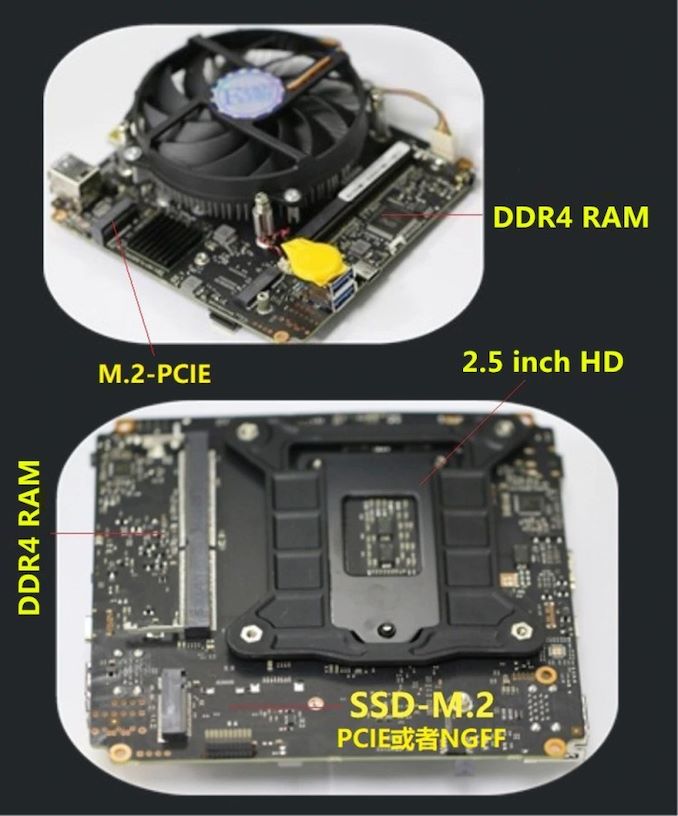

















Bookmarks